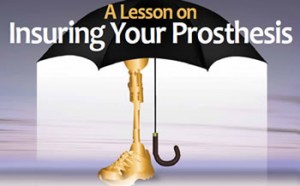Volume 19 · Issue 6 · October 2009 | Download PDF
by Tammie Higginbotham
 One day while sitting down with our insurance agent for our yearly coverage discussion, I happened to bring up the question of purchasing a “personal articles” policy to cover my prosthesis. What ensued was a very enlightening conversation between our agent, my husband, Jon, and me.
One day while sitting down with our insurance agent for our yearly coverage discussion, I happened to bring up the question of purchasing a “personal articles” policy to cover my prosthesis. What ensued was a very enlightening conversation between our agent, my husband, Jon, and me.
Jon and I found out that it is very expensive to purchase a policy to cover any prosthetic device or other costly durable medical equipment. It generally costs about $100 per $1,000 worth of coverage during each policy period – especially if the personal article you want to have insured is medically necessary. For example, if you have a $30,000 prosthesis, it can cost approximately $3,000 per policy period. That would break the bank for many households, especially in this economy.
Our agent then told us that any of my prostheses would be covered under personal property contents of my homeowner’s policy – even if they were stolen from my vehicle or damaged in a car fire or other perilous incident included in the coverage. Prosthetic devices are not covered under homeowner’s policies for simple breakage; breakage requires personal article policies to be covered.
Doing a quick tally in my head, I realized immediately that just covering what I have in prosthetic devices would very quickly eat up our coverage and leave us short somewhere. This thought hadn’t even occurred to our agent, simply because she was not familiar with the costs of prosthetic equipment.
Many people believe that anything stolen from a car would be covered under one’s automobile policy, but that’s not the case. For example, if your car is broken into and the built-in stereo, your laptop and cell phone are all stolen, the stereo would be covered under the auto policy, and the laptop and the cell phone would be covered under the homeowner’s policy. In this case, you would have to pay the deductibles for both your auto and homeowner’s policies before coverage would kick in for the stolen items.
You also need to consider whether your personal property content coverage is high enough to cover everything. Understand how much your prosthetic equipment is worth. Add up what you own in prosthetics, liners, prosthetic socks, etc. It doesn’t matter if insurance paid for these items or not, because the coverage amount is based on replacing them. Then add up what it would take to replace everything else you own inside the walls of your house. These would be items like your clothing, stereo, televisions, computers, mp3 players, furniture, any appliances, dishes, knickknacks and collectibles. Most people don’t realize what it would take to replace everything in their home. When you add prosthetic devices to it, you could most certainly be underinsured if you haven’t considered this – a dilemma that none of us would wish to find ourselves in.

A simple visit to the insurance agent proved to be very interesting and educational. Over time, we amputees tend to accumulate more prosthetic stuff than we realize. If faced with having to replace all of it, few amputees could actually do so.
Talk with your insurance agent. If you are a renter and you don’t already have it, you can also purchase insurance to cover your belongings. Never trust that your landlord has your stuff covered, because that’s not the way it works. You are responsible for insuring your own belongings.
Please understand that this covers only articles that are stolen or lost due to theft, fire or anything else that might happen in a catastrophe. Breakage is not covered. However, this is a more economical way to make sure that your prosthetic devices and equipment are covered to some extent.
So, if you haven’t had this discussion with your insurance agent, maybe now is the time to make an appointment. Even if you’ve already increased your homeowner’s policy, it’s always a good idea to review your coverage in case you have additional prosthetic equipment.
Note: This article is intended for educational purposes only. For specific advice about insurance coverage, you should consult your insurance agent.


